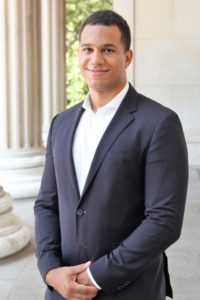Stanford’s Julian Nyarko Researches Effects of Calling Out Black Suspects by Police Agencies in Facebook Posts
As more Americans get their news from social media, how that news is reported is more important than ever. A new paper co-authored by Julian Nyarko, “Police Agencies on Facebook Overreport on Black Suspects,” looked at 14,000 Facebook pages maintained by U.S. law enforcement agencies, focusing on how they write about crime and how often they identify suspects and those arrested as Black. Here, Associate Professor of Law Nyarko discusses key takeaways from the study.

How much data did you gather for the study?
We started with approximately 16,000 departments that report UCR data [the FBI’s Uniform Crime Report] and ultimately matched about 14,000 of them to their Facebook page. From there, we looked at close to 100,000 crime reports made by these agencies in the form of Facebook posts.
Can you talk about the key conclusion, that Facebook users are exposed to posts that overrepresent Black suspects?
Yes. We first look at overreporting.
Overreporting is the proportion of Black suspects in the reports versus the proportion of Black suspects in the arrest statistic. According to this measure, Black suspects are overrepresented by 12 percentage points. But rather than focusing only on overreporting, we’re looking at overexposure as well. The way we think about overexposure is we try to determine what Facebook users are actually seeing. It‚Äôs thinking about what actually reaches the end users. If you live in Palo Alto, there’s a chance that you also see posts from Redwood City and San Francisco and so on. And so when we compute overexposure, our measure is not just affected by the posts of the user‚Äôs own police department, but also nearby police departments. If we consider overexposure, we find that Black suspects are overrepresented by 25 percentage points relative to local arrest rates.

That’s a big conclusion. Can you talk about overexposure and social consequences?
Our study did not look at the motives of police departments or make judgments. But interestingly, we find that even if we just look at arrests‚Äî police reporting that they already arrested someone, and there’s no longer a suspect at large‚Äîwe still find similar patterns of overreporting and overexposure. These patterns can lead to high societal costs, for example in the form of stigmatization. So at a minimum, law enforcement should have to tell us what the benefits are of including race. Most likely they can only justify it only in very narrow circumstances.
The reason why we focus on overexposure, which tracks with the legal concept of disparate impact, is to say, we don’t know what the motives are of the police, but we know that on the consumer side, it creates this image that there’s a very tight correlation between race and criminality, being Black and criminality. And at that point we have to ask ourselves, what are the potential benefits of reporting the race of Black suspects? We just assume that it’s normal to post about crime and to include race descriptions in crime reports. But if we try to think about what the potential benefits of these crime posts are, it’s hard to think of anything plausible. Maybe if we have a murder suspect at large, police departments could include the race description in order to enlist community support in catching the suspect. But outside of that narrow context, the benefits aren‚Äôt apparent.
You conclude that there’s a correlation between political affiliation, locality, red, purple, and blue state locality and how crime was reported and how racially tinged it was. Can you talk about that?
The reason we investigated this is because we suspected there might be heterogeneity across the ideological spectrum. And there is a strong correlation with political affiliation, with more Republican areas overreporting on crimes involving a Black suspect. But we also found that, regardless of whether you’re liberal or conservative, if the population is more white, we see more overreporting of Black suspects. This definitely requires more investigation. With regard to ideology, if it were simply a function of Republicans electing more racially conservative officials‚Äîfor example, sheriffs who might run on tough-on-crime platforms who do not care about racial disparities‚Äîthen we would expect overreporting to be more pronounced. But we found that sheriffs’ offices and police departments, whose members are, of course, not elected, were similar in their overreporting behavior.
We did see some areas where there’s less of a reporting disparity. That was the case in communities where the Black population is particularly high, as it is in a couple of southern states. And we found no relationship between the percentage of Black officers and the likelihood that there is overreporting.
What else do you want to share from the report?
This is a pervasive problem. And the data is very clear. Often with these empirical studies, it really depends on how you look at the data. But this is one study where, irrespective of how you look at it, you find this type of problem no matter how you slice and dice the data. The size of the effects are really large—25 percentage points overexposure against the baseline of 18 percent means a relative increase of over 140 percent. So the proportion of Black suspects people see in posts is more than twice as large as the proportion of Black arrestees.
Awareness of the problem is important. What are your next steps?
My personal view is that stereotypes are formed subconsciously, and so just telling Facebook users that their news is biased might move the needle a little bit, but only so much. The hope is that there’s a rethinking among police departments because there is a significant cost to the current practice. Ultimately it would be useful to consider legislation that might say that we don’t have to have race descriptions in crime reports because the outcomes can be potentially disastrous. And we‚Äôre planning follow-up studies. We’re interested in examining the political ideology angle, for instance.
Can we go back to the data? How did you get it?
Yes, it turns out there is no directory of police departments in the U.S., so we actually don’t know how many police departments there are. But we know who reports crime through the FBI‚Äôs Uniform Crime Reporting (UCR) arrest statistics. And we used Meta‚Äôs tool CrowdTangle to do searches for police departments and find lists of all Facebook pages that have phrases like ‚Äúpolice department‚Äù in them. So we pooled the data from CrowdTangle and then matched it to the police departments that report to the FBI‚Äôs UCR. But the CrowdTangle search was not perfect. So for every police department in the UCR that we couldn’t match to Facebook, which was several thousand, we went to the actual Facebook site to match them. When the dust settles, we are confident that if the police department reports the arrest data to the FBI and we don’t identify a Facebook page for them, they do not have a Facebook page.
Can you say more about UCR and how you used it in your research?
‚ÄúUCR‚Äù is an acronym for Uniform Crime Report. The FBI askes all police departments to report arrest statistics, including the race of the suspect, and publishes this data in the UCR. And so that is our on-the-ground data. And we contrast that to what the police report in the Facebook post. UCR reporting data is pretty good, though it’s not perfect, and some scholars have raised concerns. We found, for instance, that for Illinois and Florida, hardly any police departments report their arrest statistics.
Here are links to the full report¬Ý and press release about the study.¬Ý Here is a link to earlier research by Nyarko Blind Justice that looks at prosecutors and bias.
Julian Nyarko is an Associate Professor of Law at Stanford Law School, where he uses a combination of quantitative methods, natural language processing and machine learning to explore the realities of contract design under U.S. and international law. In his research, Professor Nyarko studies commercial contracts as well as consumer contracts, smart contracts and treaties. In addition, he regularly collaborates with scholars in other areas to gain insights into large bodies of legally relevant texts, such as the Congressional Record or the Federal Register.
